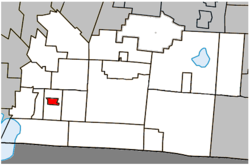Bedford, Quebec (town)
| Bedford | |
|---|---|
| City | |
 |
|
 Location within Brome-Missisquoi RCM. |
|
| Location in southern Quebec. | |
| Coordinates: 45°07′N 72°59′W / 45.117°N 72.983°WCoordinates: 45°07′N 72°59′W / 45.117°N 72.983°W | |
| Country |
|
| Province |
|
| Region | Montérégie |
| RCM | Brome-Missisquoi |
| Constituted | November 21, 1866 |
| Government | |
| • Mayor | Yves Lévesque |
| • Federal riding | Brome—Missisquoi |
| • Prov. riding | Brome-Missisquoi |
| Area | |
| • Total | 4.40 km2 (1.70 sq mi) |
| • Land | 4.20 km2 (1.62 sq mi) |
| Elevation | 53 m (174 ft) |
| Population (2011) | |
| • Total | 2,684 |
| • Density | 639.4/km2 (1,656/sq mi) |
| • Pop 2006-2011 |
|
| • Dwellings | 1,276 |
| Time zone | EST (UTC−5) |
| • Summer (DST) | EDT (UTC−4) |
| Postal code(s) | J0J 1A0 |
| Area code(s) | 450 and 579 |
| Highways |
|
| Exchange# | 248 |
| GNBC Code | EFMFP |
| NTS Map | 031H02 |
| Geocode | 2446035 |
| People | Bedfordite |
Bedford is a city located in the Montérégie region of southern Quebec, Canada. The population as of the Canada 2011 Census was 2,684. This small community is just an hour's drive from larger cities such as Burlington and Montreal, and is the home to southern Quebec's largest boy scout troop.
The first settlers arrived in 1812.
The name "Bedford" could have been given by Loyalists who knew of several Bedfords back in the former American colonies. The name could also have been a tribute to Lord John Russell, who was the fourth Duke of Bedford (1710–1771), an English politician and Secretary of State (1748–1751), and governor general of Ireland from 1756 to 1761.
Bedford is part of Brome-Missisquoi Regional County Municipality, in the administrative region of Montérégie.
The town, located 86 kilometres (53 mi) southeast of Montreal, is completely enclaved within the township of Bedford. Seated in the Saint-Lawrence lowlands, at the beginning of the steep leading to the Appalachian Mountains, the Pike River (Rivière aux Brochets) flows through the middle of the town, separating it into south and north parts.
About 20% of the population is Anglophone, many families having settled there after the arrival of the Loyalists in 1776.
...
Wikipedia

